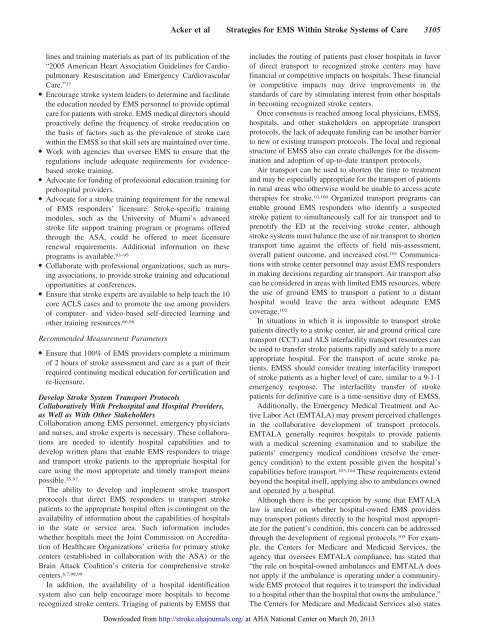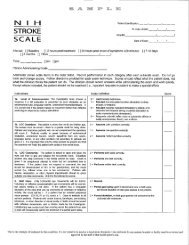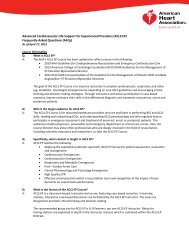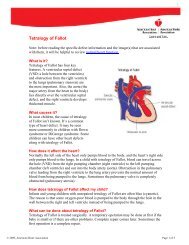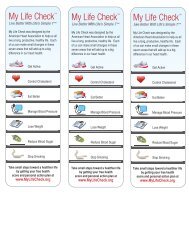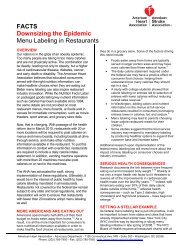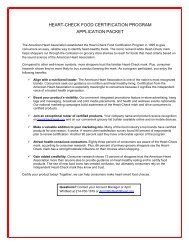2007 EMS Stroke Recommendations - American Heart Association
2007 EMS Stroke Recommendations - American Heart Association
2007 EMS Stroke Recommendations - American Heart Association
You also want an ePaper? Increase the reach of your titles
YUMPU automatically turns print PDFs into web optimized ePapers that Google loves.
Acker et al Strategies for <strong>EMS</strong> Within <strong>Stroke</strong> Systems of Care 3105<br />
lines and training materials as part of its publication of the<br />
“2005 <strong>American</strong> <strong>Heart</strong> <strong>Association</strong> Guidelines for Cardiopulmonary<br />
Resuscitation and Emergency Cardiovascular<br />
Care.” 37<br />
● Encourage stroke system leaders to determine and facilitate<br />
the education needed by <strong>EMS</strong> personnel to provide optimal<br />
care for patients with stroke. <strong>EMS</strong> medical directors should<br />
proactively define the frequency of stroke reeducation on<br />
the basis of factors such as the prevalence of stroke care<br />
within the <strong>EMS</strong>S so that skill sets are maintained over time.<br />
● Work with agencies that oversee <strong>EMS</strong> to ensure that the<br />
regulations include adequate requirements for evidencebased<br />
stroke training.<br />
● Advocate for funding of professional education training for<br />
prehospital providers.<br />
● Advocate for a stroke training requirement for the renewal<br />
of <strong>EMS</strong> responders’ licensure. <strong>Stroke</strong>-specific training<br />
modules, such as the University of Miami’s advanced<br />
stroke life support training program or programs offered<br />
through the ASA, could be offered to meet licensure<br />
renewal requirements. Additional information on these<br />
programs is available. 93–95<br />
● Collaborate with professional organizations, such as nursing<br />
associations, to provide stroke training and educational<br />
opportunities at conferences.<br />
● Ensure that stroke experts are available to help teach the 10<br />
core ACLS cases and to promote the use among providers<br />
of computer- and video-based self-directed learning and<br />
other training resources. 66,96<br />
Recommended Measurement Parameters<br />
● Ensure that 100% of <strong>EMS</strong> providers complete a minimum<br />
of 2 hours of stroke assessment and care as a part of their<br />
required continuing medical education for certification and<br />
re-licensure.<br />
Develop <strong>Stroke</strong> System Transport Protocols<br />
Collaboratively With Prehospital and Hospital Providers,<br />
as Well as With Other Stakeholders<br />
Collaboration among <strong>EMS</strong> personnel, emergency physicians<br />
and nurses, and stroke experts is necessary. These collaborations<br />
are needed to identify hospital capabilities and to<br />
develop written plans that enable <strong>EMS</strong> responders to triage<br />
and transport stroke patients to the appropriate hospital for<br />
care using the most appropriate and timely transport means<br />
possible. 35,97<br />
The ability to develop and implement stroke transport<br />
protocols that direct <strong>EMS</strong> responders to transport stroke<br />
patients to the appropriate hospital often is contingent on the<br />
availability of information about the capabilities of hospitals<br />
in the state or service area. Such information includes<br />
whether hospitals meet the Joint Commission on Accreditation<br />
of Healthcare Organizations’ criteria for primary stroke<br />
centers (established in collaboration with the ASA) or the<br />
Brain Attack Coalition’s criteria for comprehensive stroke<br />
centers. 6,7,98,99<br />
In addition, the availability of a hospital identification<br />
system also can help encourage more hospitals to become<br />
recognized stroke centers. Triaging of patients by <strong>EMS</strong>S that<br />
includes the routing of patients past closer hospitals in favor<br />
of direct transport to recognized stroke centers may have<br />
financial or competitive impacts on hospitals. These financial<br />
or competitive impacts may drive improvements in the<br />
standards of care by stimulating interest from other hospitals<br />
in becoming recognized stroke centers.<br />
Once consensus is reached among local physicians, <strong>EMS</strong>S,<br />
hospitals, and other stakeholders on appropriate transport<br />
protocols, the lack of adequate funding can be another barrier<br />
to new or existing transport protocols. The local and regional<br />
structure of <strong>EMS</strong>S also can create challenges for the dissemination<br />
and adoption of up-to-date transport protocols.<br />
Air transport can be used to shorten the time to treatment<br />
and may be especially appropriate for the transport of patients<br />
in rural areas who otherwise would be unable to access acute<br />
therapies for stroke. 10,100 Organized transport programs can<br />
enable ground <strong>EMS</strong> responders who identify a suspected<br />
stroke patient to simultaneously call for air transport and to<br />
prenotify the ED at the receiving stroke center, although<br />
stroke systems must balance the use of air transport to shorten<br />
transport time against the effects of field mis-assessment,<br />
overall patient outcome, and increased cost. 101 Communications<br />
with stroke center personnel may assist <strong>EMS</strong> responders<br />
in making decisions regarding air transport. Air transport also<br />
can be considered in areas with limited <strong>EMS</strong> resources, where<br />
the use of ground <strong>EMS</strong> to transport a patient to a distant<br />
hospital would leave the area without adequate <strong>EMS</strong><br />
coverage. 102<br />
In situations in which it is impossible to transport stroke<br />
patients directly to a stroke center, air and ground critical care<br />
transport (CCT) and ALS interfacility transport resources can<br />
be used to transfer stroke patients rapidly and safely to a more<br />
appropriate hospital. For the transport of acute stroke patients,<br />
<strong>EMS</strong>S should consider treating interfacility transport<br />
of stroke patients as a higher level of care, similar to a 9-1-1<br />
emergency response. The interfacility transfer of stroke<br />
patients for definitive care is a time-sensitive duty of <strong>EMS</strong>S.<br />
Additionally, the Emergency Medical Treatment and Active<br />
Labor Act (EMTALA) may present perceived challenges<br />
in the collaborative development of transport protocols.<br />
EMTALA generally requires hospitals to provide patients<br />
with a medical screening examination and to stabilize the<br />
patients’ emergency medical conditions (resolve the emergency<br />
condition) to the extent possible given the hospital’s<br />
capabilities before transport. 103,104 These requirements extend<br />
beyond the hospital itself, applying also to ambulances owned<br />
and operated by a hospital.<br />
Although there is the perception by some that EMTALA<br />
law is unclear on whether hospital-owned <strong>EMS</strong> providers<br />
may transport patients directly to the hospital most appropriate<br />
for the patient’s condition, this concern can be addressed<br />
through the development of regional protocols. 105 For example,<br />
the Centers for Medicare and Medicaid Services, the<br />
agency that oversees EMTALA compliance, has stated that<br />
“the rule on hospital-owned ambulances and EMTALA does<br />
not apply if the ambulance is operating under a communitywide<br />
<strong>EMS</strong> protocol that requires it to transport the individual<br />
to a hospital other than the hospital that owns the ambulance.”<br />
The Centers for Medicare and Medicaid Services also states<br />
Downloaded from http://stroke.ahajournals.org/ at AHA National Center on March 20, 2013


